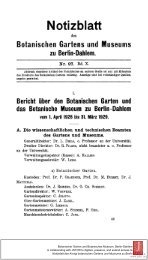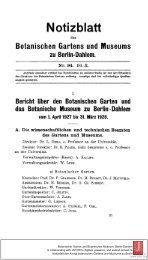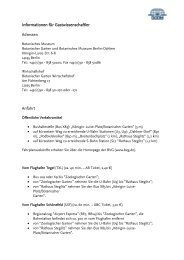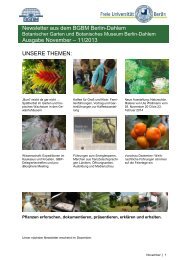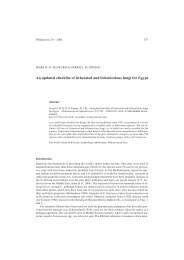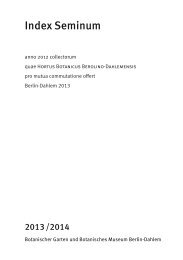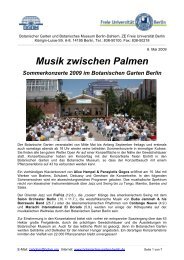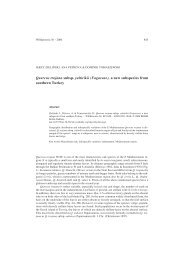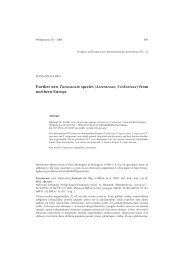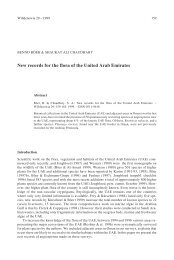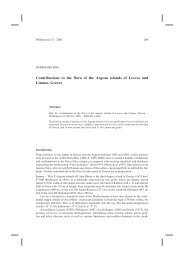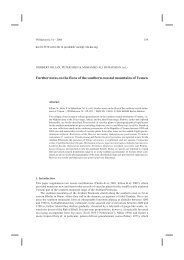The genus Dionysia (Primulaceae), a synopsis and five new species
The genus Dionysia (Primulaceae), a synopsis and five new species
The genus Dionysia (Primulaceae), a synopsis and five new species
Create successful ePaper yourself
Turn your PDF publications into a flip-book with our unique Google optimized e-Paper software.
Willdenowia 37 – 2007 47<br />
<strong>Dionysia</strong> bornmuelleri Pax calyce fere ad basim diviso lobis angustioribus, tubo corollae profunde<br />
longiore, a D. viva differt.<br />
Etymology. – Swedish “viva” means any <strong>species</strong> of the <strong>genus</strong> Primula.<br />
Lax chasmophytic subshrub with leaves crowded at branch tips; each terminal rosette with 1-2<br />
sparsely leafy “vegetative” axillary shoots, 2-6 cm long, eventually producing <strong>new</strong> terminal rosettes<br />
towards the end of the season, <strong>and</strong> with one flowering scape (rarely with second scape);<br />
defoliated stem segments with a reddish brown lustre; the leaf (remnants) crowded towards the<br />
end of the branches (stem segments) clearly discernible also in older parts; the amount of secondary<br />
growth modest, thickest stems 3-4 mm in diameter. Indumentum of green plant parts of<br />
(a) scattered sessile gl<strong>and</strong>s, (b) rather dense many-celled articulated gl<strong>and</strong>ular hairs 0.2-1 mm<br />
long, <strong>and</strong> especially on veins on the underside of leaves, (c) scattered coarse <strong>and</strong> straight, acute<br />
egl<strong>and</strong>ular hairs up to 1.5 mm. Farina woolly <strong>and</strong> mainly on the underside of leaves, at petiole<br />
bases <strong>and</strong> inside of calyx. Leaves (including petiole) 25-50 × 7-13 mm, narrowed into a long narrowly<br />
winged petiole, lamina obovate, with raised veins below, flat or (especially when young)<br />
with slightly revolute margin, coarsely dentate with obtuse to subacute primary teeth, each usually<br />
with 1-3 minute secondary teeth. Scapes (2-)5-8 cm long with 1-3 closely set whorls of flowers,<br />
each with 2-4 flowers. Bracts ovate, sessile, coarsely serrate, 9-17 × 4-9 mm (or the uppermost<br />
smaller). Calyx 9-10 mm, divided to 2 /3 into broadly oblanceolate lobes. Corolla (longstyled)<br />
yellow, sparsely crispate-gl<strong>and</strong>ular hairy in lower half, more densely so in upper half <strong>and</strong><br />
on the underside of lobes; tube 14 mm long, limb 5-6 mm broad with lobes 2 mm long, obtusely<br />
sub-rectangular in shape, sometimes with a minute notch at apex; style in long-styled flowers<br />
exserted. Capsule rounded with up to 70 dark brown small angular seeds, 0.5 mm long.<br />
<strong>Dionysia</strong> viva is vegetatively very similar to D. bornmuelleri, only somewhat less hairy <strong>and</strong> a bit<br />
smaller in all parts. It is, however, well separated on floral characters. In D. bornmuelleri the calyx<br />
is split almost to the base <strong>and</strong> the calyx lobes are narrow, the corolla tube is much longer<br />
(20-30 mm; in D. viva 14 mm) <strong>and</strong> the corolla lobes are differently shaped, being bluntly triangular.<br />
D. bornmuelleri is distributed far to the NW of D. viva.<br />
<strong>The</strong> plants of <strong>Dionysia</strong> viva in cultivation are, as can be expected, larger in most vegetative<br />
parts, <strong>and</strong> the floral whorls are more distant. <strong>The</strong>y show a surprising variation in floral width; one<br />
plant had flowers twice as broad as those of the type.<br />
18. <strong>Dionysia</strong> teucrioides P. H. Davis & Wendelbo in Aarbok Univ. Mat.-Naturvitensk. Ser. 3: 76.<br />
1961. – Holotype: Turkey, Hakkari, Cilo Dag, in Diz derezi, 6.8.1954, P. H. Davis & Polunin<br />
23884 (K;isotype:E).<br />
19. <strong>Dionysia</strong> aretioides (Lehm.) Boiss., Diagn. Pl. Orient., ser. 1, 7: 68. 1846 ≡ Primula aretioides<br />
Lehm., Monogr. Primul.: 90, t. 9. 1817 ≡ Gregoria aretioides (Lehm.) Duby in C<strong>and</strong>olle, Prodr. 8:<br />
46. 1844. – Holotype: N Iran, Ghilan, Hablitz (LE?;isotypes:B,BN,C,G,W).<br />
= <strong>Dionysia</strong> demawendica Bornm. in Beih. Bot. Centralbl., Abt. 2, 33: 301, t. 2 fig. 1. 1915. –<br />
Holotype: N Iran, foot of Mt Demaw<strong>and</strong>, Abigerm, Bruns (B; not seen, teste Wendelbo).<br />
20. <strong>Dionysia</strong> leucotricha Bornm. in Beih. Bot. Centralbl., Abt. 2, 28: 460. 1911 ≡ <strong>Dionysia</strong> aretioides<br />
var. adenophora Bornm. in Bull. Herb. Boissier, ser. 2, 3: 593, t. 6 fig. 5. 1903. – Holotype:<br />
Iran, Mt Elvend by Hamadan, Strauss (B;isotype:JE).<br />
Superficially similar to <strong>Dionysia</strong> aretioides <strong>and</strong> D. revoluta, but immediately distinguished by<br />
the peculiar calyx with long hairs at base <strong>and</strong> broad dentate lobe-apices.<br />
21. <strong>Dionysia</strong> revoluta Boiss., Diagn. Pl. Orient., ser. 1, 7: 65. 1846 ≡ Primula revoluta (Boiss.)<br />
Bornm. in Bull. Herb. Boissier 7: 73. 1899. – Holotype: Iran, Fars, Kuh-e-Sabzpuchon, Kotschy<br />
426 (G; isotypes: B, BM, K, W).<br />
= <strong>Dionysia</strong> revoluta var. canescens Boiss., Fl. Orient. 4: 18. 1879 ≡ <strong>Dionysia</strong> revoluta subsp.<br />
canescens (Boiss.) Wendelbo in Aarbok Univ. Bergen Mat.-Naturvitensk. Ser. 3: 48. 1961. –



